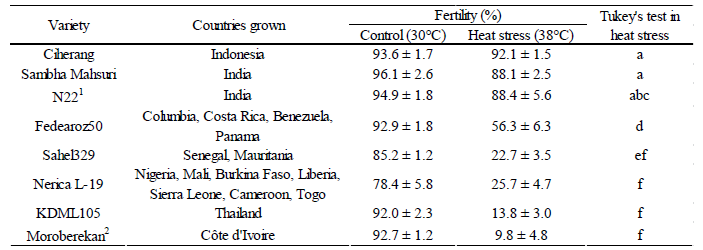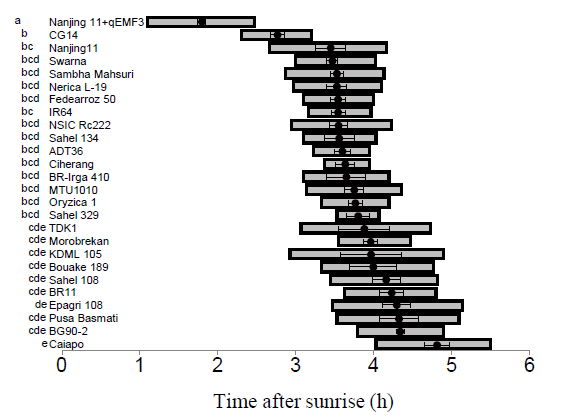Heat tolerance and flower opening time of popular rice varieties in the tropics
Description
Rice spikelets are most susceptible to heat stress at flowering, inducing spikelet sterility. Moreover, rice varieties face a higher risk of exposure to heat stress because of progressive global warming. Hence, improving heat tolerance and shifting flower opening time (FOT) to the cooler early morning period are among the recommended strategies to mitigate damage by heat stress at flowering. In this study, the heat tolerance and FOT of 23 popular varieties in the tropics were investigated.
The spikelets of 23 popular varieties were exposed to heat stress at 38°C for 6 hours (0900h-1500h) at flowering. It was found that there is a wide genetic variation in heat tolerance (Table 1). Ciherang, a popular Indonesian variety, and Samba Mahsuri, a popular Indian variety, showed high heat tolerance comparable to that of N22, the heat tolerance check variety (Table 1). This result indicated that Ciherang and Samba Mahsuri are useful new genetic resources for heat tolerance at flowering. On the other hand, Fedearoz50, a popular variety in Latin America, showed moderate heat tolerance, whereas Sahel329 and Nerica L-19, popular varieties in West Africa, and KDML105, famous aromatic rice in Thailand, showed high heat susceptibility (low heat tolerance) similar to that of Morobrekan, the heat susceptibility check variety (Table 1). These results suggested that the heat resilience of Sahel329, Nerica L-19, and KDML105 must be improved. With regard to the FOT of the 23 popular varieties, no variety had early-morning flowering (EMF) trait when compared with near-isogenic line (NIL) for EMF trait (Fig. 1), clearly indicating transferring quantitative trait locus (QTL) for EMF to these popular varieties would be effective at increasing heat escape capability at flowering. Because NIL for EMF showed significant earlier FOT than glaberrima (which is known as an EMF variety to this day ), NIL for EMF is considered a novel breeding material for improving heat resilience to cope with future hotter climates.
Figure, table
-
Table 1.Heat tolerance of popular varieties
Humidity was maintained at 60-70%. Different alphabet in Tukey’s test indicates significant difference at 5% level. 1Check variety for heat tolerance, 2Check variety for heat susceptibility. Data not shown for the rest of 16 varieties.
-
Fig. 1. Flower opening time of popular varieties, NIL for EMF (Nanjin11+qEMF3), and glaberrima (CG14).
◆ in each genotype indicates 50% FOT±SE of at least three replications. The left and right sides of the horizontal bars in each genotype indicate 10% FOT and 90% FOT, respectively. Different alphabets in left side of each genotype indicate the significance at 5% level by Tukey’s test.
- Affiliation
-
Japan International Research Center for Agricultural Sciences Biological Resources and Post-harvest Division
- Classification
-
Administration B
- Research project
- Program name
- Term of research
-
FY 2014 (FY 2010-FY 2014)
- Responsible researcher
-
Ishimaru Tsutomu ( Biological Resources and Post-harvest Division )
Sasaki Kazuhiro ( University of Tokyo )
KAKEN Researcher No.: 70513688Hirabayashi Hideyuki ( Institute of Crop Science, NARO )
Gannaban Ritchel B. ( International Rice Research Institute )
Oane W. ( International Rice Research Institute )
Shi W. ( International Rice Research Institute )
Jagadish Krishna S. V. ( International Rice Research Institute )
- ほか
- Publication, etc.
-
https://doi.org/10.2135/cropsci2014.01.0054
Shi et al. Crop Sci.
https://doi.org/10.1093/jxb/eru474Hirabayashi et al. (2014) J. Exp. Bot.
- Japanese PDF
-
2014_A03_A3_ja.pdf198.67 KB
2014_A03_A4_ja.pdf335.4 KB
- English PDF
-
2014_A03_A3_en.pdf49.14 KB
2014_A03_A4_en.pdf96.21 KB
- Poster PDF
-
2014_A03_poster.pdf273.93 KB


